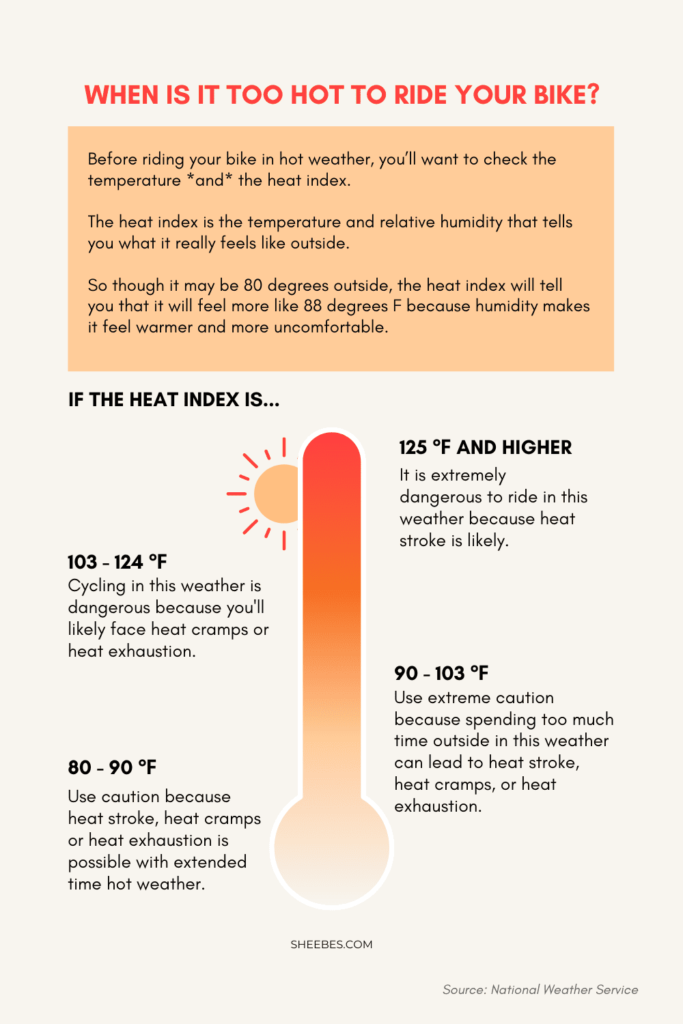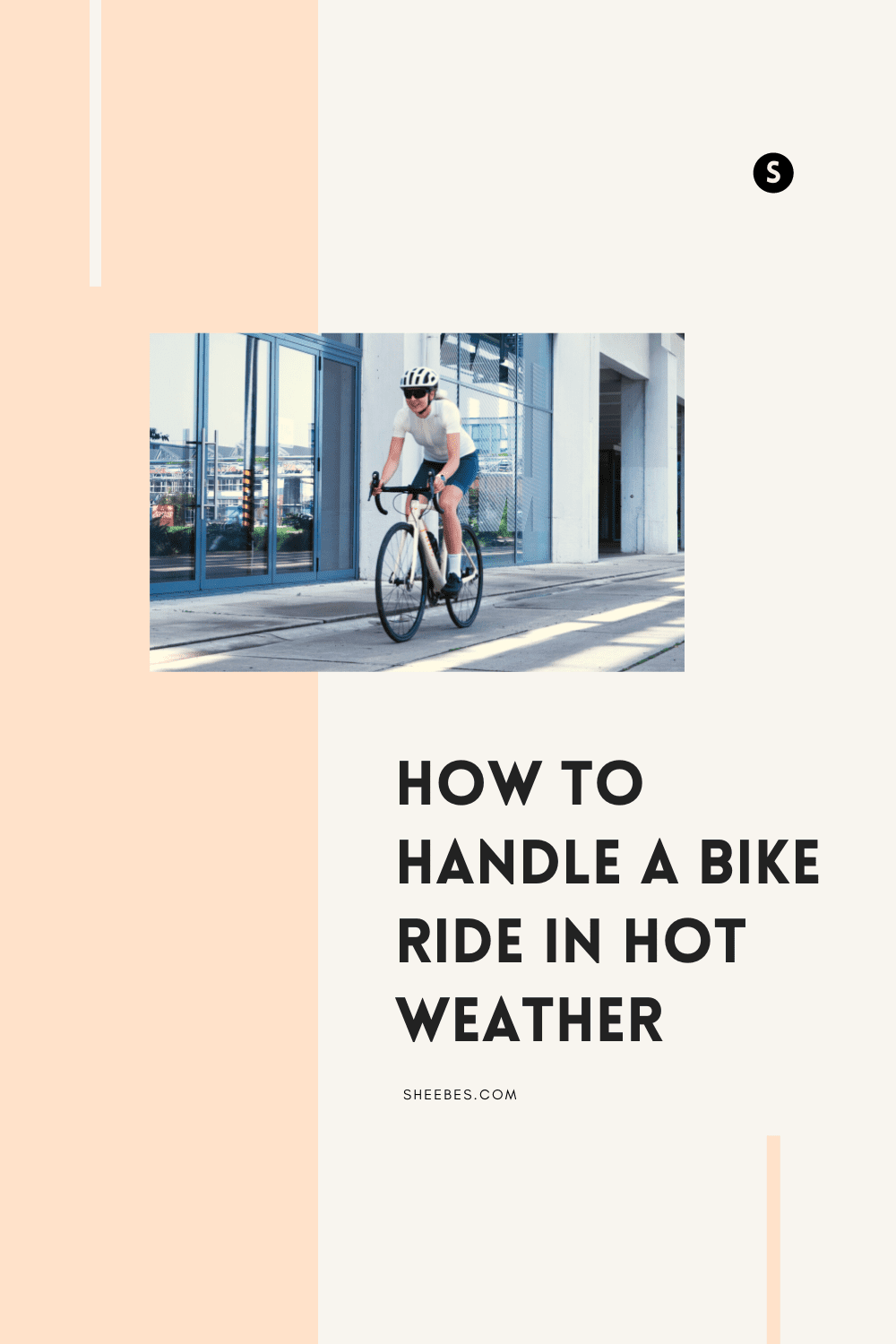With temperatures rising, you may be wondering, “Is it ok to bike in hot weather?” (You can if you pay attention to the heat index.)
“What should I wear on a hot day bike ride?” (What you put on your body should center on UV protection.)
But there are even more cycling in hot weather tips in this post, from what you need to do before your bike ride in hot weather, what to wear on a hot day bike ride, and much more.
So let’s get started on the tips you need to know on how to stay cool when cycling in the heat.

Whether you’re a runner looking for running tips or a cyclist searching for cycling advice, this site is here to help you elevate your fitness game.
Affiliate Disclosure: I’m here to help you grow as a rider and runner. So to keep things running smoothly and the content free, I participate in the Amazon Services program and select affiliate networks. So, when you click on those affiliate links, I earn a small commission at no extra cost to you.
THE CYCLING IN HOT WEATHER TIPS YOU NEED TO KNOW TODAY

Is it ever too hot to cycle? Your answer lies in the heat index
If you’ve wondered, “Is it ok to bike in hot weather?” then your answer lies in the heat index.
The heat index is the temperature and relative humidity that tells you what it really feels like outside. 1
For example, though it may be 80 degrees outside, the heat index will tell you that it will feel more like 88 degrees F because humidity makes it feel warmer.
Cycling in hot humid weather vs. Hot dry weather
Going for a bike ride in hot, dry weather differs from hot, humid weather because humidity plays a significant role in how comfortable (or rather, uncomfortable) you will feel on your ride.
You stay cool when your sweat evaporates into the air, and it disappears quickly in hot, dry weather.
But not so in hot, humid weather because the air holds more water and prevents sweat from evaporating quickly to cool you off.
So how hot is too hot for cycling? This chart from the National Weather Service can help you decide.
| HEAT INDEX | HOW THE HEAT INDEX MIGHT AFFECT YOU | |
|---|---|---|
| Use caution | 80° F to 90° F | Heat stroke, heat cramps or heat exhaustion is possible with extended time in the hot weather and/ or physical activity |
| Extreme caution | 90° F to 103° F | Heat stroke, heat cramps or heat exhaustion is possible with extended time in the hot weather and/ or physical activity |
| Danger | 103° F to 124° F | Heat cramps or heat exhaustion are likely with extended time in the hot weather and/ or physical activity |
| Extreme danger | 125° F or higher | Heat stroke is highly likely |
But note, these heat index values are for shady areas, not areas exposed to direct sunlight. If you’re in direct sunlight, the heat index value can increase by up to 15 degrees F.
Not a fan of the high heat index? Try a morning or evening bike ride when the weather is coolest.


Start slowly and ease into your bike ride
Your usual bike rides will feel more difficult in hot weather, especially your first few rides in the heat.
It’s a good idea to begin with a relaxed bike ride, to avoid overdoing it.
I can’t say that it will ever be easy exerting yourself in sweltering weather, but you will become more efficient as you continue to workout in the heat.
Your body does adapt, but it takes about 7 – 14 days of heat exposure before it happens.
Higher temps raise your heart rate but as your body becomes more efficient in heat, you’ll see your heart rate and core temperature decrease.
And you’ll start sweating earlier because your body anticipates heat buildup.
In the 7 to 14 days you’re adjusting to the heat, try relaxed bike rides, but think twice about long, high-intensity bike rides in hot weather.

What should I wear on a hot day bike ride?
Sunscreen
Sunscreen (like this fast-absorbing SPF 50 sunscreen)is an obvious tip because we’ve all heard that ultraviolet radiation may lead to skin damage, skin aging, and cancer.
But wearing sunscreen can also help you avoid both sunburn (which prevents you from cooling off) and dehydration. 2
The best way to avoid sunburn and skin damage with sunscreen, 3
- Use sunscreen with a sun protection factor (SPF) of 30 or higher when you’re riding your bike outdoors, regardless of your skin color.
- About 15 to 30 minutes before your bike ride, apply about 1 teaspoon of sunscreen to your face and neck and 1 ounce (about a shot glass full) for any exposed skin. Then, wait about 10 to 20 minutes before putting on your shorts and jersey.
- Reapply sunscreen every 2 hours
Wear UV protective cycling gear
Protect yourself even more from sunburn by wearing UV protective cycling shorts, jersey, a cycling cap (like this cycling cap with SPF 50 protection), armsleeves, and sunglasses.
Wearing armsleeves—more clothes— sounds counterintuitive when the weather is hot, but choose lightweight, light-colored armsleeves to reflect the sun and keep you cool.
And if it is still too hot, try draping cooling ice towels around your neck or ice packs stuffed into your back jersey pocket.

Drink cool (not cold) fluids on the bike
Drink cool fluids instead of icy cold ones because ice cold drinks can cause stomach cramps.
But you will need to keep your drinks cool (but not cold) throughout your bike ride, especially if your bike ride is several hours long.
To keep your drinks cool, freeze half the fluids in your water bottle before filling it to the top. If you ride with a hydration pack, fill it with ice cubes to keep your fluids (and your core) cool.
Remember to sip your fluids often, even if you don’t feel thirsty.
And it might be a good idea to bring an active hydration mix (like this active hydration mix with collagen and vitamin c) to hydrate quickly.

Eat before, during, and after your bike ride
You may not feel hungry and have little appetite when the weather soars, but you still need energy for your bike ride.
It’s tough to give you specific details on food because we all have our individual eating preferences, but what you eat before, during, and after your bike ride needs to focus on carbs.
For breakfast, that may be an extra helping of granola, noodles, rice, or cereal.
During your ride, eat food that packs calories into a lightweight, portable package. You can find plenty of packaged options such as stroopwafels, fig bars, or energy chews.
And for a homemade option, you could try onigiri (Japanese rice balls), rice wrapped in seaweed.
But if you feel like you can’t eat anything while riding in sweltering temps, an endurance drink with calories and electrolytes may be your best bet.
And after your bike ride, you’ll want to replenish the fluids and electrolytes you’ve lost through sweating.

Know when to quit
Quitting isn’t always a bad thing; it may be a very good thing when you’re showing the early signs of heat exhaustion.
If you feel any of these symptoms, stop your bike ride immediately, go to a cool place, and drink cool fluids. 4
- Cool, moist skin with goosebumps in the heat
- Heavy sweating
- Faintness
- Dizziness
- Fatigue
- Weak, rapid pulse
- Low blood pressure when standing
- Muscle cramps
- Nausea
- Headache
If you don’t feel better in an hour, contact your doctor.
I hope these cycling in hot weather tips have given you some ideas on how to stay cool on your next bike ride.
Remember, before any bike ride in hot weather,
- Check the heat index and if it is forecasted to rise to dangerous levels, consider doing your bike ride during the coolest times of the day.
- Always start slowly and ease into your bike ride.
- Stay cool by wearing sunscreen, UV cycling gear, and drinking cool fluids.
- And finally, don’t push through any signs of heat exhaustion, such as dizziness, headache, and nausea.
What you do right after your bike ride can also influence how sore you’ll feel the days after your bike ride.
And it’s why I’ve created a timeline of what to do after cycling to take the guesswork out of your cycling recovery, so grab the download today!

Sources
- National Weather Service ↩
- Centers for Disease Control and Prevention, Natural Disasters and Severe Weather ↩
- Sun protection: Appropriate sunscreen use, Harvard Health ↩
- Heat Exhaustion, Mayo Clinic ↩